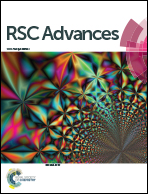Improvement of selectivity for CO2 reduction by using Cu2ZnSnS4 electrodes modified with different buffer layers (CdS and In2S3) under visible light irradiation†
Abstract
Cu2ZnSnS4 (CZTS) electrodes modified with different n-type buffer layers (CdS and In2S3) were used as photocathodes for CO2 reduction under visible light irradiation (420 < λ < 800 nm) in aqueous media. Compared to a bare CZTS electrode, CZTS electrodes modified with n-type buffer layers (CdS and In2S3), by which a p–n heterojunction between CZTS and the n-type buffer layer is formed, showed a significant increase in the photocurrent assigned to CO2 reduction. In addition, product selectivity of CO2 reduction was improved by surface modification with an n-type buffer layer: that is, selective CO2 reduction into CO was achieved by using a CdS/CZTS electrode, while HCOOH selectivity was observed over an In2S3/CZTS electrode. In this study, we investigated the photoelectrochemical properties of CZTS electrodes modified with n-type buffer layers (CdS and In2S3) in conjunction with the structural and optical properties, and we investigated their activity for PEC CO2 reduction.


 Please wait while we load your content...
Please wait while we load your content...